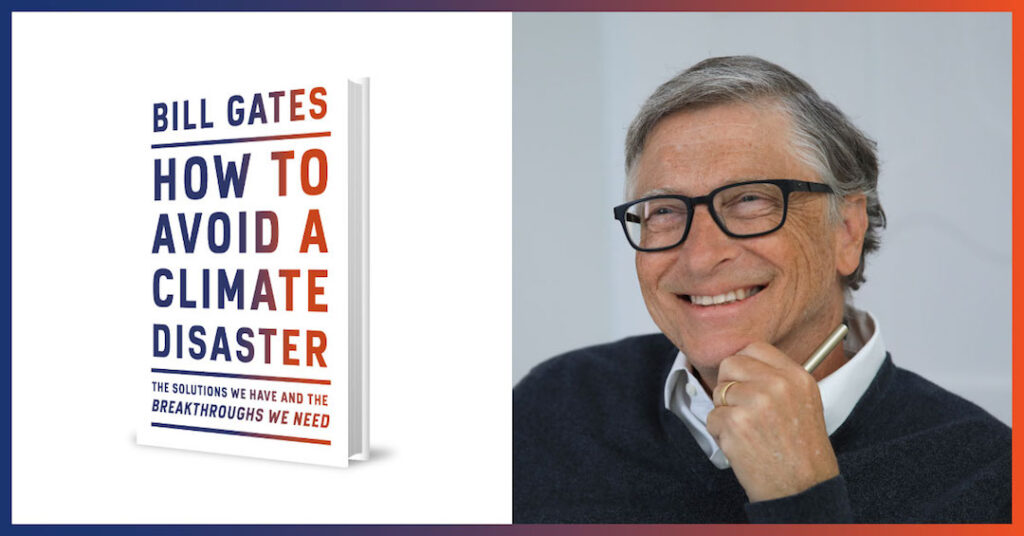BOOK REVIEW | How to Avoid a Climate Disaster: The Solutions We Have and The Breakthroughs We Need by Bill Gates
Bill Gates’ new book sets in print the illustrious thoughts of one of the greatest inventors and intellectuals of our time.

Bill Gates Battles the Climate Change Windmill
Microsoft founder billionaire Bill Gates has a new book titled How to Avoid a Climate Disaster that sets in print the illustrious thoughts of one of the greatest inventors and intellectuals of our time, never mind the richest American to ponder an environmental catastrophe that, by well-informed estimates, is only a decade away.
To be sure, Gates has already spoken and written articles before on the subject of climate change. It’s been noted that he has spent a decade investigating the causes and effects of climate change with help from experts in various fields including physics, biology and finance.
In an interview with Bloomberg in 2018, Bill Gates discussed what he then called the “the five grand challenges” to reduce greenhouse gas emissions that contribute significantly to global warming and climate change. They are:
• Electricity being the single contributor to greenhouse gas emissions globally
• Agriculture that produce 24% of greenhouse gases
• Manufacturing industry with its 21% share of the global total
• Transportation adding 14%
• Buildings and their fixtures representing just 6% which is projected to increase as more people move to the cities demanding shelter and work spaces
In his latest book, Bill Gates expounds further on these five basic challenges, breaking down each individual’s responsibility in the course of “making things, plugging in, and getting around” daily. Then, he throws in prospective solutions and breakthroughs, most technology-driven, to reduce greenhouse gas emissions to zero in the next few decades. In context, the International Panel on Climate Change (IPCC) predicts that how we deal with carbon emissions in the next decade will greatly affect the rate of future climate change. In fact, even if greenhouse gases emissions were reduced to near zero during this century, warmer climates will be expected for centuries.
For most of the book, Gates advocates that a green future is possible. He cautions though that getting greenhouse gas emissions to zero is a herculean job requiring global cooperation at every level of involvement from governments to the individual citizens. He is just as excited about the passion of the millennials to do their share to forestall an impending climate change disaster in the near term. The need to deploy and roll out breakthrough technologies that can take the world out of harm’s way is foremost in Gates’ mind as well as the faster and smarter deployment of the tools at our disposal like wind and solar.
Given his emerging stature as the most powerful figure to hitch his future to a doable climate change proposition, Gates is at the receiving end of criticisms of a hidden agenda, the least of which is that he stands to reap benefits from taking the position. The argument follows from the typical opinion that billionaires like him will never pass a chance to earn a buck in anything they do, be it a business enterprise or a selfless benevolent undertaking.
One source of reproach comes from Gates pronouncements a few year ago that solar power isn’t efficient enough and that wind power takes up “too much land”. In 2019, he even suggested that government subsidies should be directed away from wind and solar to “something new”.
Another comes from the fact that the Melinda and Bill Gates Foundation, the world’s largest private charitable foundation focused on global health and education, has about $1 billion investments in major gas and oil companies, which reportedly account for a third of the world’s greenhouse gases emissions from fossil fuels. Also at the same crosshair is Gates’ 19 percent stake in Signature Aviation, the world’s largest operator of private jets,
On a broader scale, the United States dropped out of the Kyoto protocol of 1992 which mandated a reduction in the greenhouse gas emissions of 37 industrialized nations and the European Community. President Bill Clinton signed the agreement in November 1998, but citing compliance could lead to potential damage to the US economy, the US Senate refused to ratify it. The protocol is now generally deemed a failure.
Online counter-arguments to Bill Gates’ book on grand ways to stop the coming apocalypse of drought, rising sea levels and super typhoons run the gamut from the revolutionary to the practical. An American intellectual goes through lengths that the overthrow of the elite aka big business capitalists who led the rest of us to this predicament in the first place.
A housewife suggests
• Choose a sustainable lifestyle
• Reduce, reuse, recycle
• Conserve water
• Plant a tree…but don’t forget, climate change is real!
We have the next ten years to figure out the road to take.



